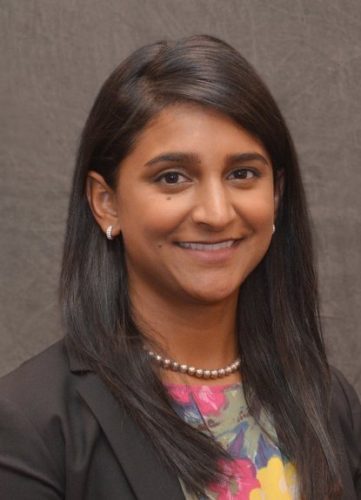Jennifer Setlur, MD, a pediatric ENT specialist at Mass Eye and Ear, Concord, explains what to do when a mysterious lump appears out of the blue.
Picture this: It’s a Monday morning and you’re helping your young child get dressed. Just as you pull their shirt up over their head, your hand catches an odd bump on their neck. You take a closer look and realize it’s not a mole or a bruise. Rather, it’s sitting underneath the skin and feels like a solid ball of exactly who-knows-what.
That lump wasn’t there a week-or-two before. Trying not to fear the worst, you can’t help but wonder if it’s something insidious.
But fear not: That mysterious lump on your child’s neck is usually much less sinister than initially thought, yet still deserves expert attention. Pediatric ENT Dr. Jennifer Setlur tells Focus what parents should do next.
First, don’t jump to conclusions
Parents must resist the urge to look for answers on the internet, said Dr. Setlur. An internet search can point to a worst-case scenario and set off a false alarm, especially if it wrongfully points to the lump being a lymphoma: A cancer that can grow from lymph nodes in the neck and easily spread to neighboring organs.
“Obviously, if you start searching ‘lump on my child’s neck,’ you’re going to get something scary,” Dr. Setlur said. “The unnecessary panic this causes is the last thing a parent needs when they think something might be wrong with their child.”
Dr. Setlur points out that lymphomas are extremely rare causes of neck masses in children. According to the American Cancer Society, the two most common types of lymphomas – Hodgkin lymphoma and Non-Hodgkin Lymphoma — account for less than 10 percent of all pediatric cancers, and only a small portion of these occur in the head and neck area. Despite, the unlikelihood of a cancerous diagnosis, parents may feel a sense of guilt for not catching the lump sooner.
“It’s natural for parents to feel a little bit guilty when they see these lumps and think, ‘Oh no, could I have done something to prevent this from happening,” she said. “In reality, there’s nothing they can do because the lumps are more natural than they think.”
What are these lumps, then?
The majority of lumps found on children’s necks are reactive lymph nodes. Existing as tiny, pearl-shaped tissues, these lymph nodes serve on the front line of the body’s immune system. They act as miniature water filters, collecting fluids full of pathogens like viruses and bacteria throughout the body and rinsing out the infectious agents. Lymph nodes are commonly found underneath the surface of the skin in the groin, armpit and neck.
When a person contracts a cold or a virus, lymph nodes collect more fluid than usual, which typically causes the nodes to swell and can result in noticeable lumps. Since a child’s immune system is less mature than that of an adult, lymph nodes can remain swollen for days, or even weeks, after a child stops experiencing the symptoms of an infection.
“Our focus is reminding parents that the nodes are just doing their job and that it’s not uncommon for them to grow into noticeable lumps,” said Dr. Setlur.
The remainder of lumps found in the head and neck area are usually cysts or pre-existing bumps present at birth. Although parents might hear the word “cyst” and feel a pit in their stomach, Dr. Setlur insists there is no cause for immediate alarm. Cysts are typically benign sacs of fluids that exist underneath the skin and are usually developmental. Developmental masses can slowly grow over time or become infected. If infected, the masses become more noticeable.
What should parents do then?
While these lumps are typically harmless, Dr. Setlur recommends that parents have their child evaluated by an ENT specialist. Specialists are well-versed in head and neck care and can definitively rule out malignancies based on a routine workup.
Workups entail an evaluation of the child’s medical history. This involves asking if the child had recently been sick, travelled or possibly exposed to animals or ticks. Depending on the response, the ENT may order an ultrasound to evaluate the size, shape and makeup of the lump. Results from the ultrasound help determine if the lump is a lymph node, cyst or pre-existing bump. The ENT may then order further bloodwork, treat the mass with antibiotics or obtain a tissue sample for a pathologist to investigate infectious causes.
Once properly diagnosed, the ENT can assign a follow-up appointment. In some instances, observation using repeat imaging and testing may be needed to account for any changes to the lump over time. Some developmental cysts or pre-existing bumps are removed if they have grown or become infected.
“We only want to remove the lump if it’s in a controlled environment and we know that a procedure wouldn’t cause complications elsewhere,” Dr. Setlur says. “It’s always best to leave invasive procedures as final options.”
Avoiding the ER or urgent care
According to Dr. Setlur, parents might assume that it takes too long to get an appointment with a specialist, which would delay care. As a result, parents may take their children to an emergency room or urgent care center after finding a lump. However, this may result in unnecessary tests and a delay in diagnosis.
Specialists in your area, like at Mass Eye and Ear’s Suburban Centers, make trips to the ER or an urgent care less necessary and can provide parents peace of mind.
“You no longer have to drive 30 or 40 minutes into Boston to see a specialist for a mysterious lump, or any other ailment specific to the head or neck area,” Dr. Setlur says. “Parents need to know that care from some of the best, specialty-trained clinicians in New England exists right in their backyard.”
About the expert
 Jennifer Setlur, MD, is a pediatric otolaryngologist who offers comprehensive ENT care for children. She sees patients at the Suburban Center in Concord.
Jennifer Setlur, MD, is a pediatric otolaryngologist who offers comprehensive ENT care for children. She sees patients at the Suburban Center in Concord.




What I have read are very helpful especially to my children. Thanks.
It’s helpful